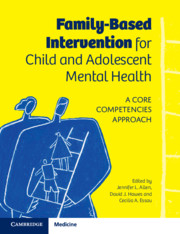Book contents
- Family-Based Intervention for Child and Adolescent Mental Health
- Family-Based Intervention for Child and Adolescent Mental Health
- Copyright page
- Contents
- Contributors
- Preface
- Part I Theoretical Perspectives on Family-Based Intervention
- Part II Core Clinical Competencies
- Part III Family Intervention for Specific Child and Adolescent Mental Health Problems
- Chapter 8 A Family-Based Approach to the Treatment of Youth Depression
- Chapter 9 A Family-Based CBT Approach to the Treatment of Anxiety Disorders in Children and Adolescents
- Chapter 10 Case Complexity and Resistance to Change in the Treatment of Child Conduct Problems
- Chapter 11 Enhancing Engagement and Motivation with Adolescents with ADHD and Their Parents
- Chapter 12 Functional Family Therapy for Antisocial Behaviour in Adolescents
- Chapter 13 Autism Spectrum Disorders in Young Children
- Chapter 14 Family-Based Treatment for Eating Disorders
- Chapter 15 Sleep Problems
- Part IV Family Intervention for Children at Risk Due to Family Dysfunction or Past Adversity
- Part V New Developments in Family-Based Intervention
- Index
- References
Chapter 13 - Autism Spectrum Disorders in Young Children
The Early Start Denver Model (ESDM)
from Part III - Family Intervention for Specific Child and Adolescent Mental Health Problems
Published online by Cambridge University Press: 18 February 2021
- Family-Based Intervention for Child and Adolescent Mental Health
- Family-Based Intervention for Child and Adolescent Mental Health
- Copyright page
- Contents
- Contributors
- Preface
- Part I Theoretical Perspectives on Family-Based Intervention
- Part II Core Clinical Competencies
- Part III Family Intervention for Specific Child and Adolescent Mental Health Problems
- Chapter 8 A Family-Based Approach to the Treatment of Youth Depression
- Chapter 9 A Family-Based CBT Approach to the Treatment of Anxiety Disorders in Children and Adolescents
- Chapter 10 Case Complexity and Resistance to Change in the Treatment of Child Conduct Problems
- Chapter 11 Enhancing Engagement and Motivation with Adolescents with ADHD and Their Parents
- Chapter 12 Functional Family Therapy for Antisocial Behaviour in Adolescents
- Chapter 13 Autism Spectrum Disorders in Young Children
- Chapter 14 Family-Based Treatment for Eating Disorders
- Chapter 15 Sleep Problems
- Part IV Family Intervention for Children at Risk Due to Family Dysfunction or Past Adversity
- Part V New Developments in Family-Based Intervention
- Index
- References
Summary
This chapter describes the background and foundations of the Early Start Denver Model, an evidenced-based, family-centered, comprehensive intervention designed specifically for the needs of very young children with autism spectrum disorders (ASD). This chapter describes the background of this model, the strategies used in the intervention and the strategies used to coach caregivers in the implementation of intervention techniques, reviews the evidence supporting the ESDM and, finally, lists the competencies required for successful delivery. A case study is used throughout the chapter to serve as an example of writing learning objectives and implementing objectives in everyday routines and activities. The purpose of this chapter is to assist clinicians, parents, educators and others in their search for evidence to support ASD intervention practices for toddlers.
Keywords
- Type
- Chapter
- Information
- Family-Based Intervention for Child and Adolescent Mental HealthA Core Competencies Approach, pp. 166 - 176Publisher: Cambridge University PressPrint publication year: 2021



